6.5×55mm Swedish
The 6.5×55mm Swedish (also known simply as the 6.5×55 mm) is a first-generation smokeless powder rimless bottlenecked rifle cartridge. It was introduced in the 1890s, and is still one of the most common cartridges in modern rifles built for the Scandinavian market today. The cartridge was developed in a joint Norwegian and Swedish effort starting in 1891 for use in the new service rifles then under consideration by the United Kingdoms of Sweden and Norway.[6] In 1893, the cartridge was standardized and adopted under the name 6.5×55 mm to facilitate logistical cooperation between Norway and Sweden. The two nations had independent armies and consequently the normal procedure at the time was for their respective governments to use the same ammunition and then purchase small arms of their choice. Norway adopted the Krag–Jørgensen M/1894 rifle, while Sweden adopted the Mauser m/1896 rifle design that was based on a Mauser service rifle designed around the 7×57mm Mauser cartridge.
| 6.5×55mm | ||||||||||||||||||||||||
|---|---|---|---|---|---|---|---|---|---|---|---|---|---|---|---|---|---|---|---|---|---|---|---|---|
6.5×55mm | ||||||||||||||||||||||||
| Type | Military Rifle | |||||||||||||||||||||||
| Place of origin | United Kingdoms of Sweden and Norway Sweden Norway | |||||||||||||||||||||||
| Service history | ||||||||||||||||||||||||
| In service | 1894–1995[1] | |||||||||||||||||||||||
| Used by | United Kingdoms of Sweden and Norway Sweden Norway | |||||||||||||||||||||||
| Production history | ||||||||||||||||||||||||
| Designed | 1891 | |||||||||||||||||||||||
| Produced | 1894–present | |||||||||||||||||||||||
| Specifications | ||||||||||||||||||||||||
| Bullet diameter | 6.71 mm (0.264 in) | |||||||||||||||||||||||
| Neck diameter | 7.60 mm (0.299 in) | |||||||||||||||||||||||
| Shoulder diameter | 11.04 mm (0.435 in) | |||||||||||||||||||||||
| Base diameter | 12.20 mm (0.480 in) | |||||||||||||||||||||||
| Rim diameter | 12.20 mm (0.480 in) | |||||||||||||||||||||||
| Rim thickness | 1.50 mm (0.059 in) | |||||||||||||||||||||||
| Case length | 55.00 mm (2.165 in) | |||||||||||||||||||||||
| Overall length | 80.00 mm (3.150 in) | |||||||||||||||||||||||
| Case capacity | 3.75 cm3 (57.9 gr H2O) | |||||||||||||||||||||||
| Rifling twist | 220 mm (1-8.66 in) | |||||||||||||||||||||||
| Primer type | large rifle | |||||||||||||||||||||||
| Maximum pressure (C.I.P.) | 380.0 MPa (55,110 psi) | |||||||||||||||||||||||
| Maximum pressure (SAAMI) | 351.6 MPa (51,000 psi) | |||||||||||||||||||||||
| Maximum CUP | 46,000 CUP | |||||||||||||||||||||||
| Ballistic performance | ||||||||||||||||||||||||
| ||||||||||||||||||||||||
| Source(s): Hodgdon[2] RWS/RUAG Ammotec[3][4][5] | ||||||||||||||||||||||||
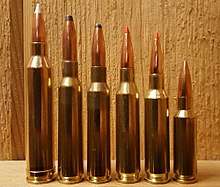
The 6.5×55mm cartridge has a smaller bullet diameter and lower free recoil than other full-power service rifle cartridges like the later developed 8×57mm, .30-06 Springfield and 7.62×51mm NATO. Thanks in part to its relatively roomy case which was designed for loading long, heavy 6.7 mm bullets, and a 12.2 mm (0.480 in) diameter bolt face, it has proven more successful than other first-generation smokeless-powder military cartridges of similar bullet calibers, such as the 6×60mm US Navy, 6.5×54mm Mannlicher–Schönauer, 6.5×53mmR Dutch Mannlicher, 6.5×52mm Carcano and 6.5×50mm Arisaka.
While the original and colloquial cartridge name is 6.5×55mm, there are some variations in chamberings. In addition to the original 1890s specification, three modern chambering and ammunition pressure variations also exist.
- 6.5×55 SE is the European C.I.P. designation with SE being the Swedish two-letter ISO country code.[7]
- 6.5×55 Swedish is the American SAAMI designation (official SAAMI abbreviation 6.5×55).[8][9]
- 6.5 × 55 SKAN is the Scandinavian designation used by the Scandinavian shooting associations DFS, DGI and SvSF.[10]
Other common but unofficial names for this cartridge include 6.5×55mm Swedish Mauser, and less commonly 6.5×55mm Mauser or 6.5×55mm Krag.
History and development
In 1886, France introduced a cartridge for use with the then-new smokeless propellant, introduced as Poudre B in the 1886 pattern 8×50mmR Lebel, which started a military rifle ammunition revolution.
In 1891, the Swedish-Norwegian Rifle Commission started its work. After extensive ballistic tests where different calibers were tested (8 mm, 7.5 mm, 7 mm, 6.5 mm etc.), the optimal caliber was determined to be 6.5 mm (0.256 in). Following this decision, a joint Norwegian-Swedish commission was established in December 1893.[6] This commission worked through a series of meetings to decide on the different measurements for the cartridge case. A rimless cartridge case of 55 mm length was approved, and each possible measurement (diameter at base, diameter at neck, angle of case, angle of shoulder etc.) was decided upon.[6] The corresponding dimensions of the cartridge chamber to be used in a future service rifle was also determined.[6] At the time of its development the 6.5×55mm was a high-performance smokeless-powder cartridge. The design of the joint Norwegian-Swedish commission was subsequently adopted by the Norwegian and Swedish governments, and entered service in the Norwegian and Swedish militaries. The cartridge was also adopted by the Danish, Norwegian and Swedish civilian shooting associations DDS, DFS and FSR.
In 1984, the C.I.P. independently standardized the cartridge as 6,5 × 55 SE, and revisioned their standard in 2002 and 2007.[11]
In 1990, a specification was introduced along with the Scandinavian target rifle by the Scandinavian shooting associations DDS, DFS and FSR with the designation 6,5 × 55 mm SKAN which tightened up the original tolerances (minimum and maximum dimensions) of the 1893 design standard, added a slightly longer chamber space for the neck for increased safety with untrimmed reloads, and increased the pressure rating. The SKAN chambering is approved for firing any 6.5×55mm cartidges satisfying the aforementioned C.I.P. and SAAMI standards.
In 1993, the SAAMI also independently standardized the cartridge as 6.5×55mm Swedish, with the official SAAMI abbreviation being 6.5×55.[9]
The closest European and American ballistic twins of the 6.5×55mm are probably the German 6.5×57mm Mauser and the American .260 Remington cartridges. While the 6.5×57mm and 6.5×55mm both require a long action receiver, the shorter .260 Remington being (based on the .308 Winchester cartridge) can be fitted to a short bolt action format. Other 21st century cartridges like the 6.5×47mm Lapua and the 6.5mm Creedmoor that have entered the market also are able to provide similar performance to factory 6.5×55mm ammunition. However, the extra case volume of the 6.5×55mm promotes a longer lifespan of the cartridge case when reloading, and will provide higher velocities when handloaded to the same pressure as its more modern counterparts. However, the approved chamber pressure ratings for older rifles then may be exceeded.
Cartridge specifications
Original specifications
All Swedish Mauser bolt actions were proof tested with a single 6.5×55mm proof round developing approximately 455 MPa (65,992 psi) piezo pressure (55,000 CUP).[12][13]
Swedish and Norwegian chamber differences rumour
Some historians have assumed that there was a difference in cartridge blueprint measurements between Swedish and Norwegian 6.5×55mm ammunition, but this may be unintentional. Due to different interpretations of the blueprint standard, i.e. the standards of manufacturing using maximum chamber in the Krag vs. minimum chamber in the Swedish Mauser, a small percentage of the ammunition produced in Norway proved to be slightly oversize when chambered in the Swedish Mauser action, i.e. requiring a push on the bolt handle to chamber in the Swedish arm.. A rumour arose not long after the 6.5×55mm cartridge was adopted that one could use Swedish ammunition in Norwegian rifles, but not Norwegian ammunition in Swedish rifles.[6] Some even alleged that this incompatibility was deliberate, to give Norway the tactical advantage of using captured ammunition in a war, while denying the same advantage to Sweden. However, after the rumour first surfaced in 1900, the issue was examined by the Swedish military. They declared the difference to be insignificant, and that both the Swedish and Norwegian ammunition were within the specified parameters laid down. Despite this finding, the Swedish weapon-historian Josef Alm repeated the rumour in a book in the 1930s, leading many to believe that there was a significant difference between the ammunition manufactured in Norway and Sweden.[6]
C.I.P. specifications
The 6.5×55mm has 3.75 ml (57.9 grains H2O) cartridge case capacity. The exterior shape of the case was designed to promote reliable case feeding and extraction in bolt action rifles and machine guns alike, under extreme conditions.
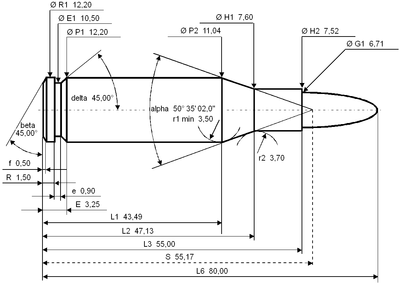
6.5×55mm maximum C.I.P. cartridge dimensions. All sizes in millimeters (mm).
Americans would define the shoulder angle at alpha/2 ≈ 25.6 degrees. The common rifling twist rate for this cartridge is 220 mm (1 in 8.66 in), 4 grooves, Ø lands = 6.50 mm (0.256 in), Ø grooves = 6.73 mm (0.265 in), land width = 2.5 mm (0.098 in), and the primer type is large rifle.
According to the official C.I.P. rulings the 6.5×55mm can handle up to 380.00 MPa (55,114 psi) Pmax piezo pressure. In C.I.P. regulated countries every rifle cartridge combo has to be proofed at 125% of this maximum C.I.P. pressure to certify for sale to consumers. This means that 6.5×55mm chambered arms in C.I.P. regulated countries are currently (2013) proof tested at 475.00 MPa (68,893 psi) PE piezo pressure.[11]
SAAMI specifications
The SAAMI maximum average pressure (MAP) for this cartridge is 51,000 psi (351.6 MPa) piezo pressure (46,000 CUP).[14][15]
SKAN specifications
The SKAN specification was introduced to tighten up the original tolerances of the 1893 design standard. Otherwise its measurements is almost identical to the original standard except for a slightly longer chamber space for the neck by less than a millimeter.[16] Complying barrels have usually been marked with "6,5 × 55 SKAN".
In 2018, the tighter C.I.P. chamber (6,5 × 55 SE) was banned from competitions in the Scandinavian shooting associations on the grounds of competitive equity and safety.[17] Since 2020, regulations changes in Germany resulted in new SKAN barrels manufactured by SIG Sauer being be marked "6,5 × 55 SE, approved for SKAN".[18]
The SKAN chambering is sometimes erronously referred to as SCAN, however SKAN is the correct designation.
Military ammunition

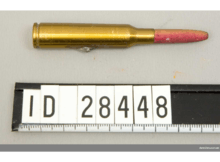

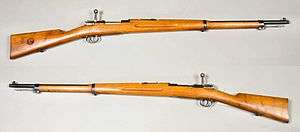
The militaries of Sweden and Norway loaded their 6.5×55mm skarp patron m/94 projektil m/94 (live cartridge m/94 projectile m/94) service ammunition with a 10.1 grams (156 gr) long round-nosed m/94 (B-projectile) bullet fired at a muzzle velocity of 725 m/s (2,379 ft/s) with 2,654 J (1,957 ft⋅lbf) muzzle energy from a 739 mm (29.1 in) long barrel up to the early phase of World War II and Norwegian occupation by Germany in 1940.
From 1941 onwards, Sweden, which remained neutral during World War II, adopted skarp patron m/94 prickskytte m/41 (live cartridge m/94 sharpshooting m/41) ammunition loaded with a 9.1 grams (140 gr) spitzer bullet (D-projectile) fired at a muzzle velocity of 800 m/s (2,625 ft/s) with 2,912 J (2,148 ft⋅lbf) muzzle energy from a 739 mm (29.1 in) long barrel.[19] Besides a pointed nose the m/41 D-projectile also had a boat tail. Originally developed for the m/41 sniper rifle, this new cartridge replaced the m/94 ammunition loaded with the M/94 projectile for general use.[20] Besides the two skarp patron (live full metal jacket ball cartridge) variants various other military 6.5×55mm ammunition types like enhanced precision, armor piercing, tracer, blank, inert and training cartridges were available. Swedish blanks or lös patron were loaded with bullet shaped wooden projectiles that were painted red. To fire these blanks the Swedish military used a Blank Firing Attachment (BFA). These adapters were mounted on the muzzle and designed to shred the wooden projectile as it exited the muzzle to prevent injuries to nearby people and to allow functioning of automatic weapons.
The Swedish 6.5×55mm military ammunition was loaded to 320 MPa (46,412 psi) piezo pressure. The maximum pressure (Pmax) for Swedish military ammunition was 330 MPa (47,862 psi).[21] That is significantly below the civilian (Pmax) standards.
Norwegian service
The 6.5×55mm cartridge was used by Norway in the Krag–Jørgensen bolt-action rifle and in the Madsen machine gun, as well as in several prototype self-loading rifles.
Swedish service
In Swedish service, the 6.5×55mm cartridge was used in the Swedish Mauser family of bolt action arms comprising the m/94 (Model 1894) carbine, m/96 (Model 1896) long rifle, m/38 (Model 1938) short rifle and m/41 (Model 1941) sniper rifle and the Ag m/42 semi-automatic rifle.[22] The Swedish Mauser arms had a relatively tight 200 mm (1 in 7.87 in) twist rate optimized for stabilizing the relatively long heavy bullets used in the Swedish 6.5×55mm military service ammunition. It was also used in several light, medium and heavy machine guns such as the Schwarzlose, Browning BAR, Kg/1940 Light machine gun, Bren Gun, Browning M1917, Browning M1919 and FN MAG. The FN MAG was eventually returned to its original 7.62×51mm NATO chambering when the Swedish armed forces switched to that cartridge as its standard during the post-World War II era.
Danish Service
In 1946 Denmark made a standard cartridge with two different bullets. The 6.5 mm skarppatroner m/46-ru had a rundspids (round tip) bullet (like the Swedish projektil m/94) for use with Danish Krag rifles by the Home Guard. The 6.5 mm skarppatroner m/46-sp had a spidsskarp (pointed tip) bullet (like the projektil m/41) for use in more modern firearms like the Swedish Mauser.
Sporting use
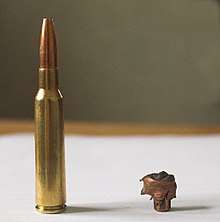
The 6.5×55mm cartridge is highly esteemed as a hunting round in Europe (particularly in Scandinavia), and North America. It is used for killing most kind of game including reindeer and moose in Scandinavia, while in most other countries it is used for killing deer and other medium-sized game. Sportsmen who favor the round laud the combination of low recoil coupled with the cartridge's inherent accuracy and superb penetrative qualities due to the high obtainable sectional density.
Despite its enduring popularity amongst a devoted niche of American sportsmen, U.S. rifle manufacturers have, for the most part, ignored the cartridge. As of 2014 there were at least four mainstream American arms manufacturers, Thompson Center, Barrett Firearms (Fieldcraft), Remington (Model 700), and Ruger producing a sporting rifle in chambered for the 6.5×55mm.[23]
European rifle makers including Blaser, CZ, Sauer & Sohn, Steyr, and Mauser Jagdwaffen GmbH offer sporting rifles chambered for this cartridge, as does the Finnish arms manufacturer SAKO/Tikka, and Japanese manufacturer Howa, while ammunition manufacturers such as Norma, Lapua, Prvi Partizan, RUAG Ammotec, Remington Arms, and Hornady offer loadings of the 6.5×55mm round that are designed for use only in modern hunting rifles that can tolerate higher chamber pressures. Finnish powder manufacturer Vihtavuori warns modern 380.00 MPa (55,114 psi) Pmax piezo pressure loadings should never be used in the Krag–Jørgensen or Swedish Mauser or similar older rifles.[24] This warning is relevant as the Danish, Norwegian and Swedish national shooting organizations strive to keep the costs of participating in their shooting events reasonable. Their rulings restrict the use of very expensive highly specialized target rifles by allowing only the use of their respective (historic) military service rifles and the SIG Sauer 200 STR rifle.
Because 6.5 mm (.264") bullets have relatively high ballistic coefficients, the 6.5×55mm has seen success in long range target matches of 300–1,000 m (328–1,094 yd). The 6.5×55mm cartridge was widely used in fullbore biathlon biathlon competitions until 1975 (when it was replaced by the .22 Long Rifle (.22 LR) rimfire cartridge), because of its inherent accuracy and historical popularity with the Scandinavian nations who have dominated this sport. The 6.5×55mm was and is used for 1,000 yd (914.4 m) target shooting disciplines like F-Class and benchrest.[25] The cartridge is also used by Scandinavian target shooters that use the Sauer 200 STR (Scandinavian Target Rifle) as their competition rifle. Metallic silhouette shooters also use the 6.5×55mm.[26] In North America the 6.5×55mm was the third most frequently mentioned caliber for hunter rifle at the 2003 Metallic silhouette Nationals.[27]
Wildcats
The 6.5×55mm case is also used as the parent case for modified variants that are not officially registered with or sanctioned by C.I.P. or SAAMI. Such cartridges which use commercial factory cases are generally known as wildcats. By changing the shape of standard factory cases (decreasing case taper or changing the shoulder geometry) the wildcatter generally increases the case capacity of the factory parent cartridge case, allowing more propellant to be used to generate higher velocities. Besides changing the shape and internal volume of the parent cartridge case, wildcatters also can change the original calibre. A reason to change the original calibre can be to comply with a minimal permitted calibre or bullet weight for the legal hunting of certain species of game. Because the 6.5×55mm offers a relatively wide short cartridge case that can be relatively easily reloaded and hence be reused several times it has been used by wildcatters. With the 6.5×55mm as the parent case wildcatters have created the 6.5×55mm Ackley Improved In the 6.5×55mm Ackley Improved the cartridge case capacity is raised to approximately 4.03 ml (62.2 grains H2O). The Ackley Improved family of wildcat cartridges are designed to be easily made by rechambering existing firearms, and fireforming the ammunition to decrease body taper and increase shoulder angle, resulting in a higher case capacity.
See also
References
- Göta Vapen. Retrieved 16 May 2013. Archived 18 May 2013 at the Wayback Machine
- "6.5x55mm Swedish Mauser". Hodgdon Reloading. Archived from the original on 5 April 2019. Retrieved 5 April 2019.
- "RWS 6,5 x 55 DK 9,1G data sheet" (PDF). RWS. Archived (PDF) from the original on 5 April 2019. Retrieved 5 April 2019.
- "RWS 6.5 x 55 EVO 10,1 G data sheet" (PDF). RWS. Archived (PDF) from the original on 5 April 2019. Retrieved 5 April 2019.
- "ANSI/SAAMI Centerfire Rifle | Z.299.4 1992 - Pages 19 and 24 of 240" (PDF). p. 13-17. Archived from the original (PDF) on 2010-11-29. Retrieved 2010-12-30.
- Hanevik, Karl Egil (1998). Norske Militærgeværer etter 1867
- C.I.P. TDCC datasheet 6.5 x 55 SE Archived 2015-05-18 at the Wayback Machine
- SAAMI Drawing 6.5x55 Swedish Archived 2012-10-21 at the Wayback Machine
- SAAMI – Z299.4 – Centerfire Rifle – 2015, PDF page 13 of 375
- Blaser løp med SE kammer - dfs.no
- C.I.P. TDCC datasheet 6,5 x 55 SE Archived 2015-05-18 at the Wayback Machine
- de Haas, Frank, Bolt Action Rifles, Northfield, Illinois: DBI Books, Inc. (1984), ISBN 0-910676-69-0, p. 31
- "6.5x55". ballisticstudies.com. Archived from the original on 16 October 2013. Retrieved 8 March 2017.
- ANSI/SAAMI Velocity & Pressure Data: Centerfire Rifle Archived 2013-07-02 at the Wayback Machine
- "A Metric Marvel: 6.5×55 Swedish Mauser". shootingtimes.com. Archived from the original on 1 February 2017. Retrieved 8 March 2017.
- Saksnummer 34/2018, Oppfølging av vedtak løp med SE kammer, Nordisk Formannsråd (Translation: National Rifle Association of Norway - Meeting protocol, case number 34/2018: Follow-up of on decisions regarding SE chamber, Nordic Chairman's Council)
- Blaser løp med SE kammer - dfs.no
- Ny merking av SIG Sauer piper - dfs.no
- Swedish Military Rifles 1894 - 1995 Archived 2013-03-15 at the Wayback Machine
- "6.5x55 Ammunition". dutchman.rebooty.com. Archived from the original on 8 March 2017. Retrieved 8 March 2017.
- Ammunitionsregister för armén, 1960
- Jones, D: Crown Jewels: The Mauser in Sweden, pp. 37, 59, 81, 93. Collector Grade Publications, 2003.
- "Venture bolt-action rifle". Archived from the original on 26 August 2014. Retrieved 23 August 2014.
- "6,5 x 55 SE / 6,5 x 55 SKAN". vihtavuori.com. Archived from the original on 12 March 2017. Retrieved 8 March 2017.
- "Tikka". Archived from the original on 23 March 2017. Retrieved 20 March 2017.
- "Lapua". Archived from the original on 23 March 2017. Retrieved 20 March 2017.
- "Michigan Rifle & Pistol Association - Rifle Silhouette Division". Archived from the original on 17 February 2017. Retrieved 20 March 2017.
Further reading
- Accurate Smokeless Powders Loading Guide Number Two (Revised), Book by Accurate Arms Co, Wolfe Publishing, 2000 p. 229
- CIP CD-ROM Edition 2003
External links
| Wikimedia Commons has media related to 6.5×55 Swedish. |